Title: Forgotten City
Site: Factory site
Credits: Director: Li Yuelin
Description
Shenyang was one of the most significant industrial cities in China. During “the first five-year plan,” Shenyang helped China’s industrial technology skyrocket and promoted China’s GDP to boom. In 1957, Liaoning had contributed 14% of China’s GDP, and Shenyang had taken up 22.7% of China’s industrial production. For all these contributions, Shenyang is called “the eldest son of the republic.” However, because of the “SOE reform” and the “industrial transformation,” most factories were abandoned and demolished, and millions of workers lost their jobs. This video is set in one of the original factory sites, “1905 Art Space”. The video aims to take a glance at Shenyang’s history in the 90s by filming the plant, facilities, as well as ordinary people.
Methods
In the first half of the video, I try to indicate that though reconstructed, some parts of the history still remain. So, during the research, I chose to film old remained industrial objects and modern visual shows and shops simultaneously. By doing this, I try to show these old stuff’s way of presence in the new city and the conflict between the old and the new. It also works as a foundation for further discussions about why and how the city is forgotten.
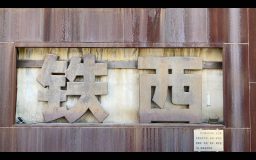
The old, rusty, iron-made sign “Tie xi.”
In this scene, I deliberately lag the time that the subtitle goes in to let the audience focus on the big sign as well as the rust on it. This can enhance the power of this scene as the first scene.
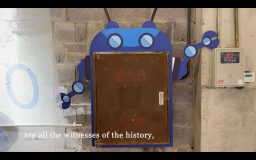
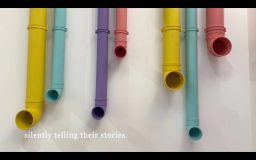
Left: An old fire hydrant decorated by a cute “robot.” Right: Old pipes painted with colors.
In most scenes in the first half of the video, I film old stuff and new stuff separately. But in these scenes, it is a combination of the two. These two scenes show how the old and the new are integrated, especially how the old is covered by the new.
Also, in the second scene, as the subtitle goes “silently telling their stories,” the pipes stay silent and still, with their exports widely open just like people’s mouths, as if they are telling something.
The second half of the video films the monument, old, abandoned machines, and people in the square outside the plant. This half focuses on the discussion on “forgotten.”
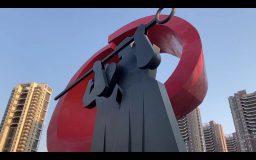 The colossal statue outside the plant called “持钎人”(Men with a drill rod).
The colossal statue outside the plant called “持钎人”(Men with a drill rod).
This scene is filmed from the bottom of the statue to show the statue’s hugeness. This also implies that Shenyang once had great importance and made significant contributions to the country.
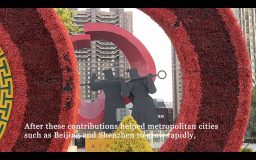
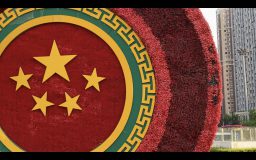
Left: The statue viewed from afar. Right: The statue is covered.
This is my favorite scene in this video. The meaning of this scene is plain and straight: as time passes by, those contributions are covered by the glamorous light of metropolitan cities and the rapid growth of the country today. This scene also contrasts with the scene with a massive statue that the outstanding contribution seems small in the historical process.


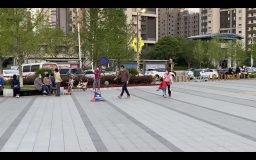
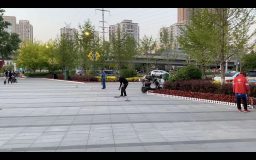
Pics: People entertaining in the square.
These scenes are filmed to contrast with the bitter experiences of those unemployed workers in the 90s.
The last sentence in the script, “there was a bunch of people, they contributed everything to create a new world, but they failed,” is cited from the documentary “Tie xi qu,” which is also about the massive layoff in the 90s in Shenyang.
Reflections
After filming, I wandered around the square, seeing elders dancing together with radiant smiles, seeing youngsters playing skateboarding, seeing parents helping their children learn how to walk. I always enjoy the time that I have in my hometown. The city was once filled with cold iron and steel, but now I can only feel its peace and warmth, like a mother’s hug. I do not plan to ask for justice for Shenyang or complain about the policies; maybe “the eldest son” is meant to shoulder the biggest responsibility in obscurity. But I still wish the people, who once gave their youth, their effort, their everything to the country, not to be forgotten.
Li Yuelin, 3035948093
Bibliography
Chinese Science and Society Network. http://www.cssn.cn/skyskl/201807/t20180724_4508992.shtml?COLLCC=3564996132&from=timeline
Marx, K., & Tzu, L. China: Breaking the Iron Rice Bowl. Re-enchanting the World, 51.
The Paper. 2016. https://www.thepaper.cn/newsDetail_forward_1549386
QUIET, I. T., & DISTURBING, S. I. Nanfang Weekend: The First Massive Layoffs in China.
Sina. “Chinese Ruhr’s glory and transformation.” 2009. http://news.sina.com.cn/o/2009-08-05/042616067684s.shtml
The State Council Information Office of the People’s Republic of China. 2019. http://www.scio.gov.cn/video/gxsp/Document/1658001/1658001.htm
Wang, bing, director. Tie xi qu. Wang bing film work shop, 2002. 9hr., 15min.
Xinhua net. 2019. http://www.xinhuanet.com/2019-10/06/c_1125074469.htm
Zhang, meng, director. Lucky dog. 2008. 1hr., 36min.
Zhang, meng, director. The piano in a factory. 2011. 1hr., 47min.
I found your content very informative and interesting, not only introducing old industrial period workers and facilities over time but also old stuff, I especially liked that colorful water pipe. The organization is also very logical, first looking at the old from a historical perspective, then moving to the new, and finally expressing the vision. I especially like your text, “silently telling their stories”, which is very visually tense with the story. At the same time, I also like your romantic background music, it’s really nice!Video clipping is also handled well. Another point I like the most is the feeling of tenderness and connection between people in the last twilight.
Thank you for your comment!
This is a micro-movie that depicts current buildings and living, however you can understand the combination of history and modernity via the introduction. I can fully comprehend the substance of the statement without any dubbing thanks to the light country music and passionate camera language. What strikes me as particularly clever is that the first shot, “Tiexi,” is sufficient to convey Liaoning Province’s industrial status as the Republic’s eldest son in the early days of the People’s Republic of China. The feeling of history in modern art is subtly expressed.
Thank you for your comment!:D